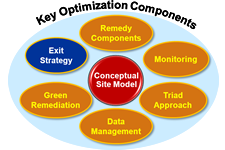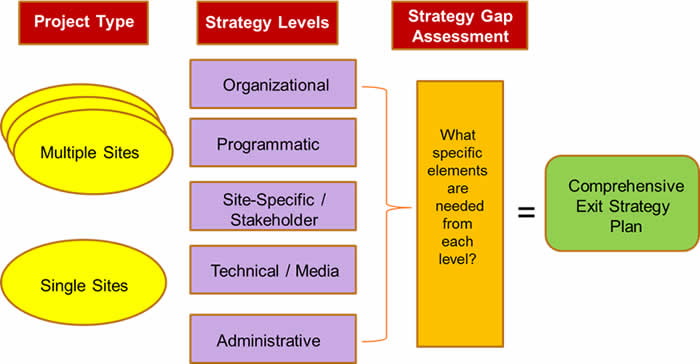For more information on Optimization, please contact:
Technology Integration and Information Branch
PH: 202-823-3081 | Email: biggs.kirby@epa.gov
Overview
Key Optimization Components: Exit Strategy
 A site exit strategy is a formal plan for guiding a site from characterization through remediation to closure or reuse. An effectively designed exit strategy supports active decision-making throughout the remediation process to maximize the opportunities to optimize remediation and monitoring efforts. A comprehensive exit strategy addresses unique and interdependent issues at various levels (including organizational, programmatic, site- and stakeholder-specific, technical and administrative) to demonstrate that performance goals have been achieved, response objectives have been met and remedial activities can be terminated.
A site exit strategy is a formal plan for guiding a site from characterization through remediation to closure or reuse. An effectively designed exit strategy supports active decision-making throughout the remediation process to maximize the opportunities to optimize remediation and monitoring efforts. A comprehensive exit strategy addresses unique and interdependent issues at various levels (including organizational, programmatic, site- and stakeholder-specific, technical and administrative) to demonstrate that performance goals have been achieved, response objectives have been met and remedial activities can be terminated.
Various exit strategy elements can be reviewed to identify key project uncertainties (data gaps) from which specific approaches for eliminating or managing them can be developed. A comprehensive exit strategy plan can increase the likelihood and efficiency of successfully completing a project or closing a site. Figure 1 shows the elements that are used to develop a comprehensive exit strategy.
Figure 1. Comprehensive Exit Strategy Design

Most projects fall under two basic categories: single sites or multiple sites, where multiple sites could be contiguous sites, multiple sites on a military installation, multiple operable units (OU) on a Superfund site or multiple solid waste management units (SWMU) on a RCRA site. The exit strategy plan must address each site and, where relevant, address the synergies and conflicts that exist when multiple sites are involved.
Each project can be viewed as having different strategy levels, within which any number of strategic issues may exist. After identifying key project uncertainties, approaches can be developed to eliminate or manage the data gaps in order to have a comprehensive exit strategy. While an exit strategy can be developed at any stage of the cleanup process, following are exit strategy components for a site in the remedial action or operations and maintenance (O&M) phase of the project life cycle.
- The decision document that identifies the selected remedial action should specify both the short- and long-term objectives for the remedy. For example, the short-term objective for a groundwater restoration remedy may be to contain the contaminated plume to a certain area while the long-term objective would be to restore the in situ quality of the groundwater to specific levels.
- The CSM should be updated with all existing information and should discuss: (1) sources and release mechanisms, (2) the detailed site hydrogeological model, (3) contaminant fate and transport, (4) current and future receptors and (5) any uncertainties associated with the CSM.
- The exit strategy should identify the actions to be taken to achieve the short- and long-term Remedial Action Objectives (RAO) and how each individual component will contribute to the RAOs.
- Performance metrics and decision logic should be developed for each engineered component of the remedy. In addition, performance metrics and decision logic should be developed for measuring achievement of the short- and long-term RAOs.
- The exit strategy should provide for contingency plans and, if appropriate, an alternative exit strategy that can be implemented if any of the components of the original exit strategy cannot be achieved.
During an optimization review, questions related to exit strategies are asked. Following are examples questions:
- Is there a site-wide or operable unit (OU) exit strategy?
- What are site-specific or stakeholder influences on the exit strategy?
- Is there a contingency plan for shifting to an alternate exit strategy?
- What is the site reuse strategy?
- What is the end goal of the exit strategy? (For example, beneficial reuse of groundwater, containment, prevention of human/ecological exposure)
- What are the greatest sources of exit strategy uncertainty?
- Can the site be closed in stages, by decision units?
- Is the CSM adequate to support risk assessment, applicable or relevant and appropriate requirements (ARAR) analysis or remedy decision?
- Are there decision logic diagrams that document the planned process of evaluating site conditions through to closure?
Selected Resources
Click on a column heading to sort the table. Search for additional publications or resources by keyword or topic using the Search page.
| Title | Document Number | Type | Date | |
|---|---|---|---|---|
| Superfund Website - Ready for Reuse (RfR) Determination Guidance | N/A | Guidance | 2011 | |
| ITRC Technology Overview: Exit Strategy - Seeing the Forest Beyond the Trees | N/A | Technical Publication | 2006 | |
| Improving Environmental Site Remediation Through Performance-Based Environmental Management | ITRC RPO-7 | Technical Publication | 2007 | |
| Low-Risk Site Closure, Guidance Manual to Accelerate Closure of Conventional and Performance Based Contract Sites | N/A | Technical Publication | 2012 |





